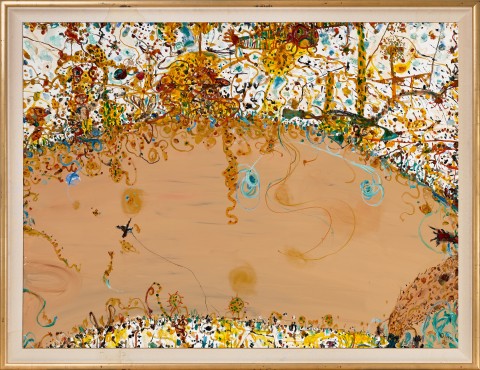LIFE UPON THE GOLDEN RIVER, 1990
JOHN OLSEN
oil on canvas
136.5 x 182.5 cm
signed and dated lower right: John Olsen / 90
Private collection
Sotheby’s, Melbourne, 19 August 1991, lot 213
Private collection
In an extraordinarily long and fruitful career totalling over seven decades, John Olsen profoundly changed the face of Australian landscape painting. The turn of 1990s marked a period of reinvigoration of the artist’s practice, adding focussed introspection and poetic narrative content to his familiar lyrical landscapes. Life Upon the Golden River, while ostensibly a landscape painting, is also a semi-autobiographical work, relating the meandering journey of Olsen’s own life to his exuberant painted records of the natural world. It was painted during a transitional period of physical and emotional upheaval, with the artist moving (with perceived finality) to the small rural community of Rydal in the Megalong Valley of New South Wales in March 1990 with his new wife, Katharine Howard.1
With an expansive horizontal composition, Life Upon the Golden River is cropped to focus on a bend in its trajectory. An earthy golden arc sweeps across the white ground, moving horizontally with an intractable force and pace, while the minutiae of Olsen’s life teems along its banks, radiating outwards in a freeform cacophony of gestural marks. Amongst the natural forms of frogs, fish and birds, also growing from the banks of the eponymous river is a grinning head in profile, itself glowing in golden hues. The caricatural protruding nose and jutting chin of this figure are characteristic of Olsen’s own image within major ruminating self-portraits-in-landscape paintings of the same period, including Donde Voy? Self-Portraits in Moments of Doubt, 1989 (private collection), Self Portrait. Travelling West, 1990 - 1992 (private collection, sold Deutscher and Hackett, 4 May 2016, lot 2) and even later, in his Archibald prize winning Self-Portrait Janus-Faced from 2005 (Art Gallery of New South Wales).
In the 1970s, disillusioned with Sydney’s relentless pace and cutthroat ambitions, Olsen sought solace in rural Victoria at his friend Clifton Pugh’s property, Dunmoochin, and since then followed a peripatetic existence, immersing himself in the physical landscape, reconnecting with painting en plein air and following a practice of intimate observation of the natural world. While many of Olsen’s landscape paintings are tied to precise geographical locations across the continent, it is likely that the “Golden River” of this painting is metaphorical, a device use to interrogate his chosen path during this crossroads, perhaps referring to the illusionary river of gold in John Ruskin’s 1842 cautionary fable The King of the Golden River.
John McDonald, reviewing Olsen’s April 1990 solo exhibition at Sydney’s Australian Galleries, the artist’s first in nine years, remarked ‘autobiographical overtones have never been so prominent, while the landscapes work as convincing metaphors for personal feeling’.2 In contrast to the darker introspective self-portraits of this period, Life Upon the Golden River is humorous, lively and engaging, infused with the joyous yellows of Olsen’s previous Clarendon works. The artist wrote of a pleasant surprise in his diary upon moving to Rydal, discovering the landscape was ‘not unlike my beloved Clarendon’.3 Indeed, here Olsen presents himself as indivisible from the landscape, finally settling into its strange and bountiful bosom. He elucidated this feeling in an interview in 2006 ‘I am in the landscape and the landscape is in me, that’s the experience that drives the line’.4
1. Olsen and Howard lived there for ten years, from 1989 - 1999. Hart, D., The Art of John Olsen, Doctor of Philosophy thesis, University of Wollongong, 1997, p. 205
2. McDonald, J., ‘Beard Growing’, Sydney Morning Herald, Sydney, 7 April 1990, p. 82
3. John Olsen cited in Hart, D., ibid.
4. John Olsen cited in Hawley, J., ‘The Masterly Mr Squiggle’, Good Weekend, Sydney Morning Herald, Sydney, 2 September 2006
LUCIE REEVES-SMITH


